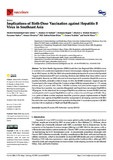Implications of Birth-Dose Vaccination against Hepatitis B Virus in Southeast Asia

View/Open
Date
2021-04-12Publisher
MDPIAuthor
Fazle Akbar, Sheikh MohammadAl Mahtab, Mamun
Begum, Ferdousi
Hossain, Shaikh A. Shahed
Sarker, Sukumar
Shrestha, Ananta
Khan, Md. Sakirul Islam
Yoshida, Osamu
Hiasa, Yoichi
Metadata
Show full item recordCitation
Akbar, S. M. F., Al Mahtab, M., Begum, F., Hossain, S. A. S., Sarker, S., Shrestha, A., . . . Hiasa, Y. (2021). Implications of birth-dose vaccination against hepatitis B virus in Southeast Asia. Vaccines, 9(4) doi:10.3390/vaccines9040374Abstract
The World Health Organization (WHO) South-East Asia Regional Office (SEARO) covers
11 countries with a combined population of about 2 billion people, making it the most populous of
the six WHO regions. In 1992, the WHO advocated including the hepatitis B vaccine in the Expanded
Program of Immunization (EPI) and vaccinating all infants and children three times within 1 year of
birth (HepB3). Recently, the WHO advocate birth-dose hepatitis B vaccination (HepB-BD) as soon as
possible after birth, preferably within 24 hours. In 2016, the SEARO endorsed a regional hepatitis
B control goal with a target of hepatitis B surface antigen (HBsAg) seroprevalence of ≤1% among
children aged ≥5 years by 2020. Of the 11 SEARO countries, four achieved this target on schedule.
Out of these four countries, two countries (Bangladesh and Nepal) have not adopted HepB-BD in
EPI program. On the other hand, the coverage of HepB3 is not satisfactory in some SEARO countries,
including India which adopted HepB-BD but could not achieve the overall target of SEARO. Thus,
it is a point of debate whether emphasis should be placed on proper implementation of HepB3
or whether a new agenda of HepB-BD should be incorporated in developing countries of SEARO.
The article discusses strengthening and expanding the Hepatitis B vaccination program in SEARO
countries with an emphasis on HepB and HepB-BD programs.
